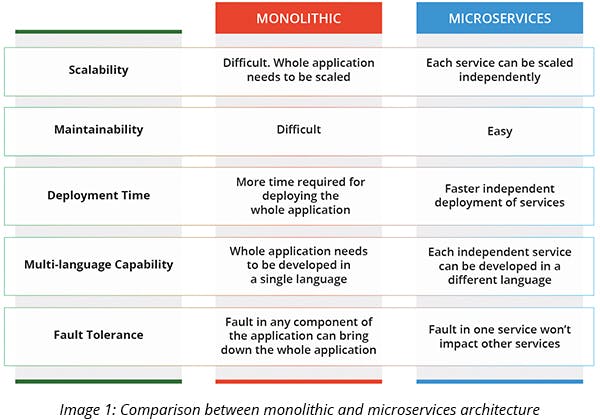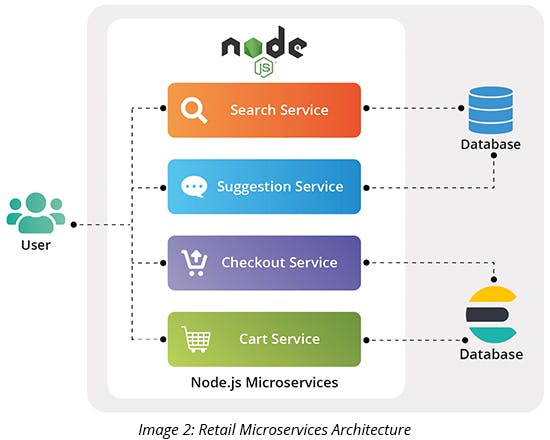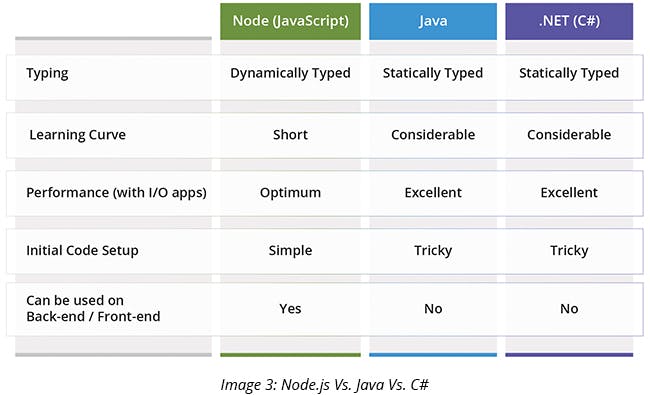Microservices is a methodology that implements a system in a loosely-coupled distributed manner. A business requires a resilient application to deal with app failures (failover handling) as it can have an immense impact on the business.
For instance, you have designed a retail application that consists of different components, such as search, suggestion, checkout, cart, etc. in a single-tiered application (monolithic approach). Now, due to some glitch in the suggestion feature, the whole application would suffer a downtime. But if the application system was designed using a microservices architecture, the whole application wouldn’t be impacted, allowing you to independently fix the suggestion feature. That’s why businesses today are choosing microservices over monolithic architecture.

On the other hand, Node.js is gaining popularity because of its remarkable features, which include handling multiple I/O (input/output) requests in a non-blocking way (event-driven non-blocking I/O), which helps in enhancing performance and scalability. Netflix, LinkedIn, PayPal, and many other big brands have switched to Node.js to reap its benefits for their systems. For example:
Netflix: Switching from Java to Node.js has helped Netflix improve their application performance to a great extent. The switch has also reduced its startup time by 70% (from 40 minutes to 1 minute).
LinkedIn: Moving from Ruby on Rails to Node.js has helped them improve the performance and efficiency of the application by 20 times, thereby reducing the infrastructure cost by 90% for serving the same traffic.
PayPal: Moving from Java to Node.js has helped them reduce the infrastructure cost by 50% to scale the same load. Their lines of code were also reduced by 1/3rd, which ultimately reduced the code maintenance effort.

Developing microservices with Node.js has become a standard today as it is easy to set up and also helps in reducing the development time. It has a lower memory footprint and better performance than Java/C# that helps in cost optimization. Let’s understand in detail what makes microservices and Node.js a go-to combination in the market today.

Benefits of Using Node.js for Microservices
We have clubbed the benefits of developing microservices using Node.js as following:
Better Performance
Node.js efficiently reduces the infrastructure requirements (CPU, Memory) for serving the same number of requests that ultimately save costs. With JavaScript, you can save time taken during the compilation phase since it is an interpreted language that ultimately helps in increasing the performance.
In Node.js, a module is cached from the first instance. After that, every time you would require the module, you’d be accessing the cached instance. Since Node.js comes with a standard streaming API, it provides the best performance and secure development for real-time applications like chat or online games.
Quick Learning Curve
Node.js has a quick and easy learning curve as compared to Java or .NET. As Node is based on JavaScript, the developers with prior JavaScript experience can quickly understand the Node.js ecosystem and start working on it. People with a background in C#/Java/Python can also easily learn Node.js.
Faster Development, High Productivity, and Scalability
With Node.js, lines of code are reduced by around 2 or 3 times as compared to Java or .NET, which helps in improving the maintainability.
As both Node and UI Frameworks code is based on JavaScript, it helps in increasing productivity by bridging the gap between front-end and back-end developers. Also, developers don’t require any explicit data parsing for consumption on UI Layer as both used JSON format for communication.
Given its fantastic non-blocking event-driven I/O to write non-blocking code, Node.js is extremely fast for low CPU, I/O-driven applications (database queries, API calls, etc.) It performs well when integrated with NoSQL database architecture as both Node and NoSQL are well versed with JSON data.
Node Package Manager (NPM) provides numerous reusable packages that simplify the development. As per the latest Google statistics, the number of available NPM modules is almost double when compared to Java.
User-Friendly: Easy to Set Up, Integrate, and Maintain
Node.js code is easy to set up and maintain as compared to its counterparts like Java/.NET/Python. It does not require complex setup configurations. With frameworks like Express, Sail, and Hapi, Node.js provides quick API development and setup.
Microservices communications can be mainly done in two ways - API calls and message brokers. Node.js provides easy and quick integration with most of the latest message brokers, like RabbitMQ and Kafka. In turn, Node.js is best suited for distributed systems. It also provides support for building full-stack applications—back-end and front-end—with templating engines such as EJS, Jade, etc. As with Microservices, we are also moving towards Serverless Architecture – Node.js is best suitable for Lambda (Serverless) because of its lower memory footprint and lightweight code, which ultimately helps in cold start time.
Challenges in Using Node.js for Microservices
While there are numerous advantages of using Node.js for developing Microservices, there are a few limitations as well:
Limited Performance with CPU-intensive Tasks: When it comes to working with CPU-intensive applications, Node.js blocks the application to complete the request (CPU-intensive) and puts all incoming requests in a queue. With this nature, the application may become unresponsive.
Unstable Node API: Node APIs are updated with the upcoming versions. Sometimes, these updates are not backward compatible. When that happens, it may lead to instability of the application made on Node.js since the developers may need to modify the code to ensure that it works with the latest Node.js versions.
Inefficient with Relational Databases: It is evident that Node is excellent when integrated with NoSQL database architecture as they both have an underlying structure based on JSON. But when it comes to working with relational databases, Nodes has proven to be a tad inefficient and less performant.
Un-verified/Outdated NPM Packages: The number of available NPM packages is almost double in Node.js as compared to Java, C#, etc. Since a lot of them are not verified, they don’t usually meet the standards and provide immature tools.
To conclude, for building microservices, Node.js is more beneficial owing to its advantages as compared to disadvantages. Node.js helps in quick application development and also fits perfectly for building real-time and I/O-based applications.
Endnote
To build microservices, Node.js is best suited for AWS Lambda and more beneficial owing to its advantages as compared to disadvantages. Node.js helps in quick application development and also fits perfectly for building real-time and I/O-based applications.



